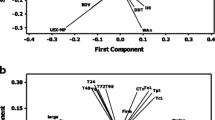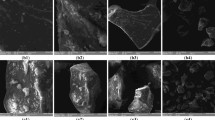Abstract
Mixolab properties of different Indian extraordinarily soft (Ex-SW), hard (HW) and medium hard (MHW) wheat varieties were evaluated and related to damaged starch content, particle size distribution, pasting, Farinographic and Mixographic properties. Water absorption (WA) of HW varieties was higher as compared to other varieties. Higher damaged starch led to more WA in HW varieties while lower in Ex-SW varieties. Unextratable polymeric protein, damaged starch and arabinoxylans were related to dough consistency. Mixolab measurement C3 (peak viscosity) and C5 (starch retrogradation) decreased with increase in grain hardness index, damaged starch content, and sodium solvent retention capacity. Dough stability (DS) and dough development time (DDT) measured by Mixolab and farinograph were significantly correlated. Mixolab parameters (C3, C4 and C5) related positively to DDT and DS while negatively to WA. HW varieties showed higher shear thinning as compared to MHW and Ex-SW varieties. C4 (hot paste stability) was lower for HW but higher for Ex-SW varieties. SuSRC was negatively related to C4 indicating that HW flours had lower starch retrogradation due to higher arabinoxylans. C3, C4 and C5 related positively to small size particles while negatively to large size particles. Slope beta (β) measured by mixolab indicated that the speed of starch gelatinization was lower for Ex-SW varieties than MHW and HW varieties.


We’re sorry, something doesn't seem to be working properly.
Please try refreshing the page. If that doesn't work, please contact support so we can address the problem.
Similar content being viewed by others
Abbreviations
- DDT:
-
Dough development time
- DS:
-
Dough stability
- Ex-MP:
-
Extractable Monomeric protein
- Ex-PP:
-
Extractable Polymeric protein
- GHI:
-
Grain hardness index
- LASRC:
-
Lactic acid SRC
- NaSRC:
-
Sodium carbonate SRC
- PCA:
-
Principal component analysis
- SRC:
-
Solvent retention capacity
- SuSRC:
-
Sucrose SRC
- UnEx-MP:
-
UnExtractable Monomeric Protein
- UnEx-PP:
-
UnExtractable Polymeric Protein
References
Banu I, Stoenescu G, Ionescu V, Aprodu I (2011) Estimation of the baking quality of wheat flours based on rheological parameters of the Mixolab curve. Czech J Food Sci 29:35–44
Codina GG, Mironeasa S, Bordei D, Leahu A (2010) Mixolab versus alveograph and falling number. Czech J Food Sci 28:185–191
Dubat A (2010) A new AACC International approved method to measure rheological properties of a dough sample. Cereal Food World 55:150–153
Gaines CS (2000) Collaborative study of methods for solvent retention capacity profiles (AACC method 56-11). Cereal Food World 45:303–306
Gujral HS, Sharma B, Khatri M (2018) Influence of replacing wheat bran with barley bran on dough rheology, digestibility and retrogradation behavior of chapatti. Food Chem 240:1154–1160
Heo S, Lee SM, Shim JH, Yoo SH, Lee S (2013) Effect of dry-and wet-milled rice flours on the quality attributes of gluten-free dough and noodles. J Food Eng 116:213–217
Hrušková M, Švec I, Jurinová I (2013) Changes in baking quality of composite wheat/hemp flour detected by means of Mixolab. Cereal Res Commun 41:150–159
Katyal M, Virdi AS, Kaur A, Singh N, Kaur S, Ahlawat AK, Singh AM (2016) Diversity in quality traits amongst Indian wheat varieties I: flour and protein characteristics. Food Chem 194:337–344
Katyal M, Singh N, Virdi AS, Kaur A, Chopra N, Ahlawat AK, Singh AM (2017) Extraordinarily soft, medium-hard and hard Indian wheat varieties: composition, protein profile, dough and baking properties. Food Res Int 100:306–317
Katyal M, Singh N, Chopra N, Kaur A (2019) Hard, medium-hard and extraordinarily soft wheat varieties: comparison and relationship between various starch properties. Int J Biol Macromol 23:1143–1149
Kaur A, Shevkani K, Katyal M, Singh N, Ahlawat AK, Singh AM (2016) Physicochemical and rheological properties of starch and flour from different durum wheat varieties and their relationships with noodle quality. J Food Sci Technol 53:2127–2138
Koksel H, Kahraman K, Sanal T, Ozay DS, Dubat A (2009) Potential utilization of Mixolab for quality evaluation of bread wheat genotypes. Cereal Chem 86:522–526
Mironeasa S, Codina GG, Mironeasa C (2012) The effect of wheat flour substitution with grape seed flour on the rheological parameters of the dough assessed by Mixolab. J Texture Stud 43:40–48
Morris VJ (1990) Starch gelation and retrogradation. Trends Food Sci Technol 1:2–6
Moza J, Gujral HS (2018) Mixolab, retrogradation and digestibility behavior of chapatti made from hulless barley flours. J Cereal Sci 79:383–389
Papouskova L, Capouchova I, Kostelanska M, Skeríkova A, Prokinova E, Hajslova J et al (2011) Changes in baking quality of winter wheat with different intensity of Fusarium spp. contamination detected by means of new rheological system Mixolab. Czech J Food Sci 29:420–429
Rosell CM, Marco C, García-Alvarez J, Salazar J (2011) Rheological properties of rice-soybean protein composite flours assessed by Mixolab and ultrasound. J Food Process Eng 34:1838–1859
Rosell CM, Altamirano-Fortoul R, Don C, Dubat A (2013) Thermomechanically induced protein aggregation and starch structural changes in wheat flour dough. Cereal Chem 90:89–100
Sandhu RS, Singh N, Kaler RSS, Kaur A, Shevkani K (2018) Effect of degree of milling on physicochemical, structural, pasting and cooking properties of short and long grain Indica rice cultivars. Food Chem 260:231–238
Sandhyarani MR, Bhattacharaya KR (1989) Rheology of rice-flour pastes. Effect of variety, concentration and temperature and time of cooking. J Texture Stud 20:127–137
Sharma B, Gujral HS, Solah V (2017) Effect of incorporating finger millet in wheat flour on Mixolab behavior, chapatti quality and starch digestibility. Food Chem 231:156–164
Shevkani K, Singh N, Singh S, Ahlawat AK, Singh AM (2011) Relationship between physicochemical and rheological properties of starches from Indian wheat lines. Int J Food Sci Technol 46:2584–2590
Shinde SV, Nelson JE, Huber KC (2008) Soft wheat starch pasting behaviour in relation to A- and B-type granule content and composition. Cereal Chem 80:91–98
Singh S, Singh N, Isono N, Noda T (2010) Relationship of granule size distribution and amylopectin structure with pasting, thermal and retrogradation properties in wheat starches. J Agric Food Chem 58:1180–1188
Singh N, Kaur A, Katyal M, Singh AM, Ahlawat AK, Bhinder S (2016) Diversity in quality traits amongst Indian wheat varieties II: paste, dough and muffin making properties. Food Chem 197:316–324
Torbica A, Draskovic M, Tomic J, Dodig D, Boskovic J, Zecevic V (2016) Utilization of Mixolab for assessment of durum wheat quality dependent on climatic factors. J Cereal Sci 69:344–350
Wong RBK, Lelievre J (1982) Rheological characteristics of wheat starch measured under steady shear conditions. J Appl Polym Sci 27:1433–1440
Xiao ZS, Park SH, Chung OK, Caley MS (2006) Solvent retention capacity values in relation to hard winter wheat and flour properties and straight-dough bread making quality. Cereal Chem 83:465–471
Acknowledgements
NS acknowledges CSIR, New Delhi for providing funds in the form of a research project. Also acknowledges Dr. Anju Mahendru Singh, Division of Genetics, Indian Agricultural Research Institute, New Delhi 110012, India for providing the material.
Author information
Authors and Affiliations
Corresponding author
Additional information
Publisher's Note
Springer Nature remains neutral with regard to jurisdictional claims in published maps and institutional affiliations.
Electronic supplementary material
Below is the link to the electronic supplementary material.
Rights and permissions
About this article
Cite this article
Singh, N., Gujral, H.S., Katyal, M. et al. Relationship of Mixolab characteristics with protein, pasting, dynamic and empirical rheological characteristics of flours from Indian wheat varieties with diverse grain hardness. J Food Sci Technol 56, 2679–2686 (2019). https://doi.org/10.1007/s13197-019-03756-z
Revised:
Accepted:
Published:
Issue Date:
DOI: https://doi.org/10.1007/s13197-019-03756-z




